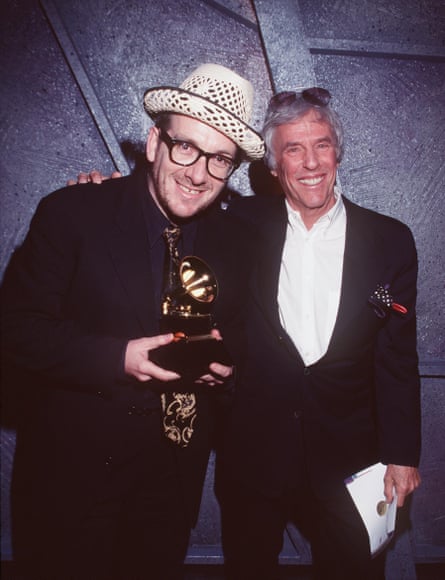I’m Just A Lucky So And So – that’s a lyric Mack David wrote in 1945 for Duke Ellington, the same Mack David who co-wrote Baby It’s You with Burt Bacharach, a song I first heard performed by the Beatles.
Yet despite these links back to its very beginnings, Burt Bacharach isn’t part of the dull orthodoxy of rock music. When a dogmatic journalist faulted his absence from the rock’n’roll revolution in the 1950s, Bacharach responded, “I was studying with the French modernist composer Darius Milhaud and listening to Dizzy Gillespie. Bill Haley just didn’t make it for me.”
When John Lennon cheekily suggested the Royal Box “rattle yer jewelry” at the 1963 Royal Variety Performance, Burt was backstage rehearsing Where Have All The Flowers Gone?, as musical director for Marlene Dietrich.
And long before my first exposure to distorted electric guitars or a Tamla drum beat, my musical curiosity began with the comical bassoon part on Perry Como’s version of the early Burt Bacharach/Hal David song Magic Moments, playing on the radio in our basement flat, near Olympia, west London, in 1958.
Bacharach’s practically unbroken collaboration with David from that time until 1973 gave the world more songs than anyone can sing in one evening, perhaps a week of evenings. If they had only written the bridge of Alfie they would have given more to music than a whole bargain bin of progressive rock concept albums. It doesn’t matter that Tom Jones thought What’s New Pussycat? was a prank when Burt first played it to him, this was the man who wrote, Walk On By, The Look of Love, A House Is Not a Home, I Say a Little Prayer – as sung by Aretha Franklin – while Manfred Mann, Mel Tormé and Love were left to arm-wrestle over My Little Red Book. Even today, you are probably only 20 feet or as many minutes away from some kind of rendition of one of his compositions.
Bacharach’s music is sometimes blandly labelled “easy listening” because of its restraint, something almost completely erased in contemporary ballad construction, assembled like Lego. In truth, his music can be exacting, famously employing uneven time signatures, which might seem like just a clever numbers game until one encounters Anyone Who Had a Heart. Burt told me that musicians used to the common, even pulse of 1950s ballads in 6/8 were perplexed by his use of odd bars of 3/8, 9/8 and one of 7/8 that turns up in the coda of this song. They represent the way longing takes your breath away or makes your heart skip a beat or nine.
There are few singers today, or perhaps at any time, with the gifts of Dionne Warwick, who first recorded Anyone Who Had a Heart – with apologies to Cilla Black fans. Dionne began working as a demonstration singer for Burt and Hal, but they quickly recognised that she had a unique voice at both ends of the dynamic and musical range, unerringly accurate when confronted with the unusual intervals in Burt’s melodies and at the same time able to inhabit the rhythmically precise narratives of Hal’s lyrics.
I can speak with some experience about this latter challenge, as from 1995 until just a few weeks before Burt’s passing we were collaborators, writing more than 30 songs together. It wasn’t as if Burt needed to add a single storey to his tower of song by the time we wrote God Give Me Strength, but the curious experience of writing via long-distance correspondence only made us want to get into the room together to see what else might be discovered, which we did first at his writing studio in Santa Monica, then behind two keyboards in a grand New York hotel suite and finally working at a dilapidated spinet in a Greenwich Village apartment.
Obviously, I took care of the words but it was a mark of Burt’s curiosity that he permitted me to write some songs in musical dialogue with him. Having never studied a note of music at school or college, I found working with Burt more of an education than I’d been offered in my 50 years of writing songs. He was extreme in his focus on the details. If I was up working at 3am, I would find out later that Burt had been up until 4am. “I no longer drive myself mad going for 110%,” he said, “I settle for 95%.”
While in no way attempting to cast myself as Oscar Hammerstein Jr, I believe Burt Bacharach to be the heir to Richard Rodgers in the continuity of American songwriting. On the one occasion when I persuaded Burt to play a song by another composer, he played the Rodgers and Hart song Little Girl Blue. It sounded as if it might have been one of his own compositions.
Burt’s many collaborations with his third wife, Carole Bayer Sager, including That’s What Friends Are For and Arthur’s Theme (Best That You Can Do), would have to take the Oscar role in this story over my slim folio of co-written songs. But while Burt’s life and work ran alongside so many innovations in popular song, his was always an instantly recognisable musical voice, one that adapted in time, the way Rodgers travelled from My Funny Valentine to You’ll Never Walk Alone.
Burt was once and for always. I have nothing but gratitude for the time we spent together.

